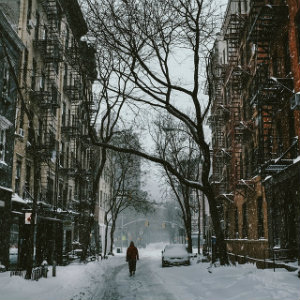Have you or a family member been injured in a fall on ice or snow? You may be wondering about legal options:
- Who is responsible for my fall?
- How will I pay for my medical care?
- What if I'm forced to miss time at work?
- Do I have a case for a lawsuit?
Our personal injury lawyers are here to answer your concerns and fight for the compensation you deserve.

The experienced lawyers at Monheit Law have helped countless fall victims recover damages for their injuries. We're ready to help you.
In Pennsylvania, the winter months tend to bring some dangerous weather conditions. Although we’ve adapted to it in some ways, storms of heavy snow and ice still present a variety of dangers and inconveniences to our daily routines. Icy, slick, and wet roads make driving much riskier and these same conditions also make our sidewalks more dangerous.
While public services and snow plows may take care of the streets, it is the responsibility of property owners to make sure their premises are safe during dangerous winter weather. Sidewalks, steps, staircases, and parking lots all see plenty of foot traffic, and allowing them to remain untreated makes the risk of a serious pedestrian injury practically inevitable.
Those who have been injured on ice and snow as a result of a property owner’s negligence may miss time at work, be saddled with unreasonable medical bills, and undergo unnecessary pain and suffering. In such cases, a lawsuit may be necessary in order to return to a normal way of life.
What Constitutes Negligence In PA?
Pennsylvania’s climate regularly creates dangerous weather conditions. The state’s premises liability laws take these climate conditions into account. Slip and fall injuries caused by icy and snowy conditions must fulfill certain criteria in order to prove negligence on the part of the property owner.
FREE CONSULTATION
Hills And Ridges Doctrine
Under Pennsylvania law, property owners are bound by the Hills And Ridges Doctrine. This law establishes rules for clearing ice and snow which account for the specific climate conditions of this region. Slippery or icy walking conditions in and of themselves are not quite enough to prove negligence in a slip and fall accident. Instead, there are a few more specific criteria which a plaintiff must prove:
- Snow and ice had accumulated on the sidewalk in ridges or elevations of such size and character as to unreasonably obstruct travel and constitute a danger to pedestrians traveling thereon.
- The property owner had notice, either actual or constructive, of the existence of such condition.
- It was the dangerous accumulation of snow and ice which caused the plaintiff to fall.
Because of the high frequency of winter weather conditions in this region, lawmakers adopted this doctrine to protect property owners from unreasonable burdens related to clearing walking surfaces. For example, it would be extremely difficult to clear an icy or snowy walkway during the middle of the storm. Therefore, a property owner may not be held liable for an accident which occurred during or immediately after a storm. However, ignoring accumulations for days afterward may constitute negligence.
Exceptions To Hills And Ridges
The Hills And Ridges Doctrine is complicated and must be applied on a case by case basis. There are exceptions to this rule which depend on the specific circumstances of the case.
Underlying Defects
If it can be proved that icy conditions were caused by a defect in the underlying surface, then the property owner may still be found negligent without satisfying the three criteria of the Doctrine.
For example, in Clayton v. Durham, 417 A.2d 1196 (Pa. Super. 1980), the court found an exception to this rule because a sidewalk depression had caused water to accumulate and freeze. By failing to correct this fault, the property owner was found negligent.
Isolated Patches
Exceptions are also made if a fall resulted from an isolated patch of ice, and the general conditions of the area were not icy or slippery. For example, if a pedestrian slips on a patch of ice outside of a business several days after a snowstorm, there is a good chance that the property owner would be found negligible for not clearing the patch.
Common Injuries
Dangerous walking conditions can lead to serious injuries. These injuries may affect victims for weeks, months, or in extreme cases, leave them permanently disabled. Some examples of common injuries include:
- Broken bones - The impact of a fall on hard concrete can easily lead to bone fractures.
- Traumatic brain injuries - Many S&F victims hit their heads hard once they land on the ground, which can lead to a traumatic brain injury such as a concussion.
- Back injuries - Victims who land on their back may experience an array of back problems, including broken vertebrae and chronic back pain.
- Bruises - Serious bruising may occur which can make daily life and normal physical motions unnecessarily painful.
- Spinal cord injuries - In some cases, victims may suffer from serious spinal cord injuries. These are some of the most serious injuries and can leave victims permanently disabled or even paralyzed.
The recovery process for these injuries is extremely taxing for victims - often leading to high medical bills, loss of income and working potential, pain and suffering, and a loss of quality of life. If an insurance policy proves inadequate for covering expenses, a personal injury lawsuit may be the best way to hold at-fault parties responsible for the negligence which caused a serious injury.
More Slip & Fall Info
Monheit Law Montgomery County Office 215-866-2018
Directions to our Montgomery County Injury Law Office
4V4Q+FM Jenkintown, Pennsylvania
Open 24 hours
Fall on Ice and Snow attorney Jenkintown
Civil law attorney
Employment attorney
Law firm
Attorney
Social security attorney
Monheit Law South Philly Office 215-302-0095
Directions to our South Philly Injury Law Office
WRCH+CP Philadelphia, Pennsylvania
Open 24 hours
Fall on Ice and Snow attorney South Philly
Civil law attorney
Employment attorney
Law firm
Attorney
Social security attorney
